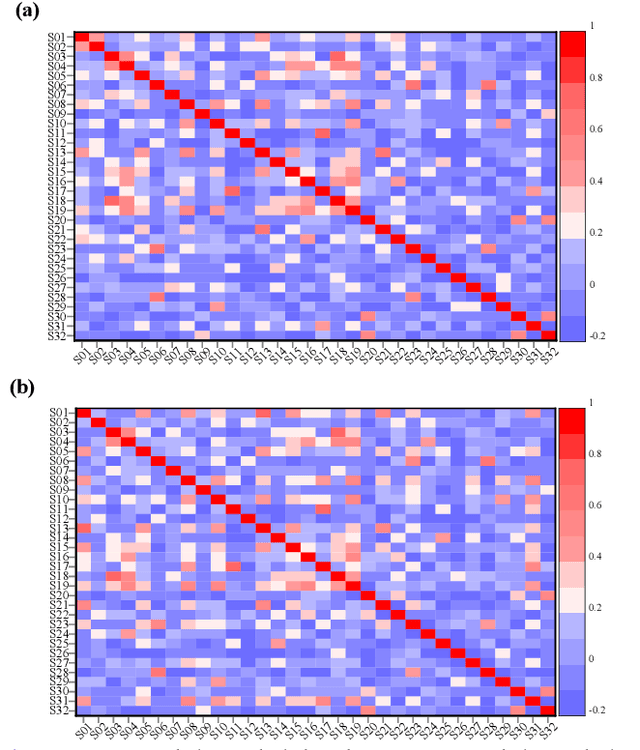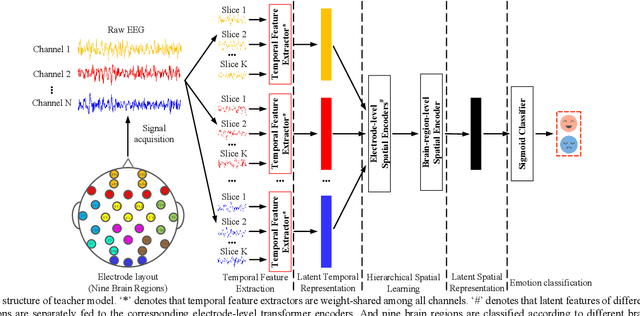Yiheng Tang
A Lightweight Domain Adversarial Neural Network Based on Knowledge Distillation for EEG-based Cross-subject Emotion Recognition
May 12, 2023



Abstract:Individual differences of Electroencephalogram (EEG) could cause the domain shift which would significantly degrade the performance of cross-subject strategy. The domain adversarial neural networks (DANN), where the classification loss and domain loss jointly update the parameters of feature extractor, are adopted to deal with the domain shift. However, limited EEG data quantity and strong individual difference are challenges for the DANN with cumbersome feature extractor. In this work, we propose knowledge distillation (KD) based lightweight DANN to enhance cross-subject EEG-based emotion recognition. Specifically, the teacher model with strong context learning ability is utilized to learn complex temporal dynamics and spatial correlations of EEG, and robust lightweight student model is guided by the teacher model to learn more difficult domain-invariant features. In the feature-based KD framework, a transformer-based hierarchical temporalspatial learning model is served as the teacher model. The student model, which is composed of Bi-LSTM units, is a lightweight version of the teacher model. Hence, the student model could be supervised to mimic the robust feature representations of teacher model by leveraging complementary latent temporal features and spatial features. In the DANN-based cross-subject emotion recognition, we combine the obtained student model and a lightweight temporal-spatial feature interaction module as the feature extractor. And the feature aggregation is fed to the emotion classifier and domain classifier for domain-invariant feature learning. To verify the effectiveness of the proposed method, we conduct the subject-independent experiments on the public dataset DEAP with arousal and valence classification. The outstanding performance and t-SNE visualization of latent features verify the advantage and effectiveness of the proposed method.
STILN: A Novel Spatial-Temporal Information Learning Network for EEG-based Emotion Recognition
Nov 22, 2022



Abstract:The spatial correlations and the temporal contexts are indispensable in Electroencephalogram (EEG)-based emotion recognition. However, the learning of complex spatial correlations among several channels is a challenging problem. Besides, the temporal contexts learning is beneficial to emphasize the critical EEG frames because the subjects only reach the prospective emotion during part of stimuli. Hence, we propose a novel Spatial-Temporal Information Learning Network (STILN) to extract the discriminative features by capturing the spatial correlations and temporal contexts. Specifically, the generated 2D power topographic maps capture the dependencies among electrodes, and they are fed to the CNN-based spatial feature extraction network. Furthermore, Convolutional Block Attention Module (CBAM) recalibrates the weights of power topographic maps to emphasize the crucial brain regions and frequency bands. Meanwhile, Batch Normalizations (BNs) and Instance Normalizations (INs) are appropriately combined to relieve the individual differences. In the temporal contexts learning, we adopt the Bidirectional Long Short-Term Memory Network (Bi-LSTM) network to capture the dependencies among the EEG frames. To validate the effectiveness of the proposed method, subject-independent experiments are conducted on the public DEAP dataset. The proposed method has achieved the outstanding performance, and the accuracies of arousal and valence classification have reached 0.6831 and 0.6752 respectively.
 Add to Chrome
Add to Chrome Add to Firefox
Add to Firefox Add to Edge
Add to Edge